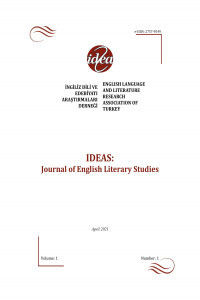The Representation of Communitas in the Forest of Arden: Shakespeare’s As You Like It
The Representation of Communitas in the Forest of Arden: Shakespeare’s As You Like It
In As You Like It, Shakespeare creates the Forest of Arden as a transitional liminal site where the characters undergo a process of becoming and transformation. While it is possible to analyse the individual experience of liminality and focus on the influence of the liminal place on the characters of the play, the play has a revealing case for the examination of the collective experience of liminality as well. Communitas, in Victor Turner’s terms, refers to a group or a community’s going through a rite of passage en masse. Accordingly, the group of exiles living in Arden who escape from the tyranny of Duke Frederick develop a bond of equality and a sense of freedom in an anti-structural attitude. Duke Senior and other courtiers in the forest communally experience liminality during the period between their separation from the court and their eventual return. Moreover, Duke Senior’s daughter, Rosalind, and her cousin Celia are engaged in the same process upon their arrival to Arden. While both of these groups fit into Turner’s definition of communitas and particularly share certain characteristics of ideological communitas, their experience can be grounded on the basis of their gender that divides them into two as male communitas and female communitas. This paper aims to scrutinise how these two groups collectively experience liminality in Arden and to explore the nuances of each communitas by framing the issue in Turner’s conceptualisation of the term.
Keywords:
Shakespeare, As You Like It, Liminality Communitas,
___
- Barton, Anne. The Shakespearean Forest. Cambridge UP, 2017. Cambridge Core. Accessed 19 Sept. 2019.
- Berry, Edward. Shakespeare’s Comic Rites. Cambridge UP, 1984.
- Bulman, J. C. “As You Like It and the Perils of Pastoral.” As You Like It from 1600 to the Present: Critical Essays, edited by Edward Tomarken. Garland, 1997, pp. 597-602.
- Downey, Dara, Ian Kinane, and Elizabeth Parker. “Locating Liminality: Space, Place, and the In-Between.” Landscapes of Liminality: Between Space and Place, edited by Downey, Kinane and Parker. Littlefield, 2016, pp. 1-26.
- Everitt, Alan. Landscape and Community in England. Hambledon, 1985.
- Gifford, Terry. Pastoral. Routledge, 2010.
- Griffiths, Paul, Adam Fox, and Steve Hindle. Introduction. The Experience of Authority in Early Modern England, edited by Griffiths, Fox and Hindle. Macmillan, 1996, pp. 1-9.
- Harrison, William. Elizabethan England: From “A Description of England”, edited by Lothrop Withington. W. Scott, 1577. The Project Gutenberg. Accessed 1 Mar. 2022.
- Howard, Jean E. The Stage and Social Struggle in Early Modern England. Routledge, 1994.
- McFarland, Thomas. Shakespeare’s Pastoral Comedy. U of North Carolina P, 1972.
- Patterson, Annabel. Shakespeare and the Popular Voice. Blackwell, 1989.
- Phillips, Edward. The New World of Words: Or, Universal English Dictionary. J. Philips, 1720. Internet Archive. Accessed 3 Mar. 2022.
- Pollard, A. J. “Political Ideology in the Early Stories of Robin Hood.” Outlaws in Medieval and Early Modern England: Crime, Government and Society, c.1066-c.1600, edited by John C. Appleby and Paul Dalton. Ashgate, 2009, pp. 111-128.
- Potter, Nick. “As You Like It: The Outlaw Court.” Shakespeare Out of Court: Dramatizations of Court Society, edited by Graham Holderness, Nick Potter and John Turner. Macmillan, 1990, pp. 86-104.
- Shakespeare, William. As You Like It, edited by Juliet Dusinberre. The Arden Edition, Bloomsbury, 2006.
- Theis, Jeffrey S. Writing the Forest in Early Modern England: A Sylvan Pastoral Nation. Duquesne UP, 2009. Project Muse. Accessed 28 Mar. 2019.
- Tomarken, Edward. “As You Like It from 1600 to the Present: Critical Essays.” As You Like It from 1600 to the Present: Critical Essays, edited by Tomarken. Garland, 1997, pp. 3-75.
- Turner, Edith. Communitas: The Anthropology of Collective Joy. Macmillan, 2012.
- Turner, Victor. The Anthropology of Performance. PAJ, 1988.
- ---. Blazing the Trail: Way Marks in the Exploration of Symbols, edited by Edith Turner. U of Arizona P, 1992.
- ---. The Ritual Process: Structure and Anti-Structure. Aldine Transaction, 1969.
- Young, David. The Heart’s Forest: A Study of Shakespeare’s Pastoral Plays. Yale UP, 1972.
- Zajac, Paul Joseph. “The Politics of Contentment: Passions, Pastoral, and Community in Shakespeare’s As You Like It.” Studies in Philology vol. 113, no. 2, 2016, pp. 306-336. Project Muse, doi: 10.1353/sip.2016.0013.
- Başlangıç: 2021
- Yayıncı: İngiliz Dili ve Edebiyatı Araştırmaları Derneği / English Language and Literature Research Association of Turkey
Sayıdaki Diğer Makaleler
Possibilities of Habit-Change in The Essex Serpent: A Semiotic Analysis of Cora Seaborne
Review of Doris Lessing: Marksizmden Sufizme Bir Yaşam Felsefesi
Animal Subjectivity and Ethics of Care: Human-Nonhuman Relations in Doris Lessing’s On Cats
The Representation of Communitas in the Forest of Arden: Shakespeare’s As You Like It
The Satirical Vision of Canadian/Scottish Songwriter, Poet, and Novelist Graeme Williamson
Roaring Youth Subculture as Street Gang in A Clockwork Orange
